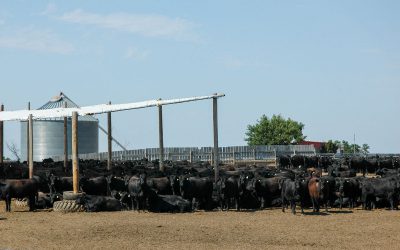
Confessions from a corn/cattle girl
May 18, 2011
I grew up in farm country–corn and soybeans (and now quite a few hog barns) as far as the eye can see.
As a matter of fact, I read somewhere a few years back that 97% of the land in our Minnesota county is in row crops. My family’s operation had livestock, but profit or loss was more focused on what was in the fields rather than the fences.
That’s probably why whenever there’s a change in seasons it reminds me of some activity related to farming. When spring arrives in my rural location (although it seems like it’s taken its dear sweet time this year), I smell the tilled dirt and see tractors in the field and I long to be home for corn planting. I’m reminded of my early years riding with my mom or grandpa in the tractor and later bringing supper to the field.
That probably also explains why when listening to farm markets and I hear that corn is up, the farm kid in me thinks, “Yippee.” Then I put on my cattle industry hat and think, “Oh, boy, what now?!”
I know cattle producers are resourceful people and you take a variety of approaches to dealing with high corn prices. One of them is undoubtedly looking for substitutions. Distiller’s by-products used to be an easy answer, but anyone I’ve talked to in the last couple years indicates those prices closely mimic the corn market.
So what other options have you looked into? Are there any new feedstuffs on the horizon that will help ease the pain?
As you search, we hope you’ll consider all the effects of these new options.
For example,,a recent report from Iowa State University looked at feeding chemically treated corn stover. It sounds good at first, because it’s cheaper and improves feed-to-gain ratios. But when you dig into the data, it shows marbling scores are reduced by up to 82 points. When you think of all the cattle that teeter on the line between Choice and Select or Choice and Premium Choice (the marbling level required for CAB), that’s significant.
The numbers reflect that. The control group had an average carcass value of $1,276.65, which was $140 more than the lowest valued treatment group (baled stover-fed cattle had $1,135.71 carcasses). That’s real money. Nobody wants to save cash on inputs only to lose it on the end product.
Plus, we’ve always got an eye on long-term demand and I guarantee that lowering quality isn’t the way to build that.
What side of the corn equation are you on? We’d love to know how you’ve responded to record high prices.
May your bottom line be filled with black ink,
~Miranda
You may also like
Purpose Follows Passion
A chance opportunity. A change in career direction. And meat science was changed forever. Dr. Gary Smith originally had no plans to become a meat scientist. But thank goodness he did.
Certified Angus Beef Recognizes Beef Quality Research
First-place honors go to Andres Mendizabal, an international student pursuing a Ph.D. in animal science at Texas Tech University. His research is titled, “The Accuracy of USDA Yield Grade and Beef Carcass Components as Predictors of Red Meat Yield.”
Not all good days are sunny and warm
Stress of any kind affects performance and health, but also well-being and behavior, a special focus for CSU animal scientist Lily Edwards-Callaway. Her team’s literature review found shade benefits vary by location, structure type and the weather.



